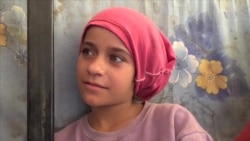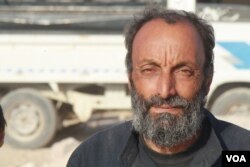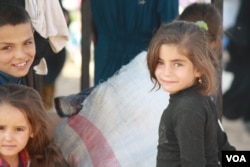“I went to all of the executions,” said Abd Hassan Shaban, a 50-year-old father of seven, a week after fleeing the final battles in Raqqa, Syria. “I had relatives in prison. I wanted to see who they were killing.”
People were beheaded, shot, or bludgeoned to death in Raqqa, Shaban added, and Islamic State militants hanged their bodies, or just their heads, on the fence in the center of town. Na'eem Square, or Heaven Square, soon became nicknamed Hell Square.
“It’s better to know if they are dead than wonder,” Shaban added.
In mid-October, IS was driven out of Raqqa as the remaining families fled the battle. Making the city once again livable, according to officials, is now an overwhelming task complicated by a political deadlock. Rebuilding lives after mass trauma, they add, may be close to impossible.
Children talk about the horrors of the final days of IS in Raqqa:
Accused of aiding the enemy
“I once asked a Daesh fighter why they left the bodies in the square,” Shaban continued, using an Arabic acronym for IS. “He told me, ‘So the people will learn to behave.’”
Near the corpses and sometimes directly on them, IS fighters wrote a description of the "crime" that led to the victim’s execution. Most people were killed after being accused of assisting any of the various militaries fighting IS, including the Syrian Democratic Forces (SDF), a Kurdish-led umbrella group backed by the United States and the official Syrian Arab Army, backed by Iran and Russia.
“My nephew was 14 years old when Daesh caught him with a photo of a destroyed house,” said Um Ali, Shaban’s wife. “They said he was giving information to the coalition forces, but he really just wanted to show the family who owned the house.”
Before rebuilding
Aside from the countless lives lost and ruined, Raqqa is devastated and dangerous, according to officials. It will take months or even years to make the city habitable again, said Ibrahim al-Hasa, who heads the rebuilding committee for the Raqqa Civil Council, a governing body backed by the SDF.
“There are still bodies under the rubble,” he said in his office in Ain Issa, where Raqqa authorities have set up offices about 70 kilometers outside the city. “The electricity network is totally destroyed. The water systems, sewers and schools are all badly damaged.”
Before rebuilding can even begin, added Mustafa Bali, a spokesperson for the SDF, which now controls the city, all urban areas and much of the countryside need to cleared of bombs planted by IS.
“Our technical units specialized in de-mining are working and they are preparing some parts of the city for civilians to return,” he said. “But it will take some time.”
‘Dark times’
As Syrian, Iraqi and international forces close in on recapturing all IS-held areas in both countries, de-mining and rebuilding are only the beginning of recovery, Bali added.
“On an ideological level it will take years,” he said. “We need to rebuild a new generation without the dark ideas that were planted in these dark times.”
When families arrive at camps outside of battle zones, the emotional damage caused by years of violence and months of all-out war is obvious, added Sherin Musa, the co-director of the Ain Issa camp, where tens of thousands of displaced people languish, waiting for a chance to go home.
“You can see the impact of war on the children’s behavior,” she said. “Some behave violently. Some refuse to speak. Some are constantly afraid.”
Hurdles
Efforts to rebuild Raqqa city and the lives ruined as it was destroyed are also complicated by politics.
Damascus views Raqqa as “occupied” by U.S.-backed forces. Last week, a top adviser to Iran’s Supreme Leader, Ali Akbar Velayati, said Syrian federal forces plan to reclaim the city.
SDF leaders call the city “liberated,” saying they will allow the people in Raqqa and other areas the SDF captured from IS decide if they are part of the semi-autonomous Kurdish northeast of Syria.
The SDF, however, has also said it will not leave areas it now controls, despite having no former claims to places like Raqqa and Deir el-Zour, two major cities governed by Damascus before IS.
“When we fight and die for a place, we don’t abandon it later,” said SDF spokesperson Leelwa Abdullah.
Starting with ‘small things’
Getting international aid into Raqqa is also difficult and time-consuming, according to al-Hasa, of the Raqqa Civil Council.
The SDF is led by the Kurdish People’s Protection Units, or YPG, a military group viewed as terrorists by neighboring Turkey.
A considerable amount of the aid needed to clear mines, rubble and rebuild the city has been pledged to Raqqa authorities from 13 different countries as well as aid organizations, he said, but very little has made it into Syria.
Rebuilding lives, he added, is already part of their plans.
“We can change small things about the city,” al-Hasa said. “For example, we can change the shape of the square where so many crimes were committed. We will remove the fences where the heads were hung.”













